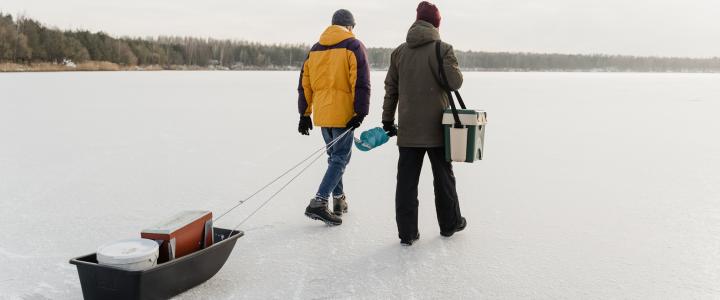
January 2022: Ice In, Carry Out: ‘Leave No Trace' While Ice Fishing
Here in New Hampshire, recreating on our lakes doesn’t stop when the ice takes over, and neither does our need to protect them from many sources of pollution. Even under several inches to several feet of ice, lakes are susceptible to pollution from natural sources but also from a variety of winter activities that take place on them. One of the most common activities involving lakes in winter is ice fishing.
Some hardy souls trek out to face the elements with little shelter other than a thick pair of overalls and a jacket, others set up camp on the lake and use it like a second home. Whether you call them bobhouses, shanties, or ice houses, these structures allow ice anglers refuge from the elements while participating in an exciting wintertime activity. Some bobhouses are staked out in one location all season, while others are designed for mobility, allowing anglers the ability to relocate.
Whether you pack light or bring a lot of creature comforts with you, it’s important to take care with your ice-fishing gear – so that you don’t inadvertently harm the lakes you rely on for the big lunker fish. Here are some of the common items used during a day of fishing on the ice, or generated while spending a day on the ice, and the problems they can pose for water quality and aquatic life:
Lead-based tackle: State law prohibits the sale and use of lead sinkers weighing 1 ounce or less and lead jigs less than 1 inch long along their longest axis. Small lead tackle such as sinkers, sounders or jigs can be lost through the hole and sink to the lake bottom. During the open water season loons and other waterbirds can pick these up when they swallow small pebbles from the bottom, causing lead toxicity and death. Use only non-lead-based tackle.
Plastic jigs and tube baits: These can float around the lake and wash up on beaches, causing hazards to barefoot shoreline visitors or wildlife. They can also be swallowed by a variety of birds and other wildlife. Keep track of your jigs and make sure to take out what you bring in. If you come across any of these items while out on the ice, please remove them.
Live bait: Live bait, though regulated, can occasionally contain non-native species or carry pathogens that are dangerous to aquatic life. Never dump bait on the ice or down a hole in the ice. Carry it off the lake and dispose of it in the trash.
Petroleum products: A day of ice fishing can include fuel for heating, power augers, all-terrain vehicles, snowmobiles and more. Petroleum, if spilled in the lake, can be toxic to aquatic life. Petroleum can also trigger algal blooms that harm water quality. Take the utmost care in using and storing petroleum products when you are on the ice and avoid leaks and spills. Remember to never leave gas cans behind in your bobhouse.
Human waste: If you’ve got to go… please don’t go on the ice or down a hole in the ice. Human waste contains pathogens and bacteria that are harmful to humans and animals alike, and nutrients that are harmful to lake health. The sensible thing to do would be to bring a portable, self-containing toilet or to use a nearby bathroom to take care of personal needs.
General trash: All types of trash are generated during a day of ice fishing, including bait containers, food wrappers, beverage containers, spent fuel cans and more. Carry out what you carried on the ice and dispose of it properly. State laws prohibit any person to leave any waste on a surface water, ice over that water, or even on the banks. Importantly, when the season is over and you remove your bobhouse, remember to take with you the rope, cable tie-downs or wood blocks used to secure it in place.
Fires directly on the ice are also highly discouraged. Wood ash left after a fire contains high levels of phosphorus and other nutrients and minerals that are harmful to lake health. Phosphorus, in particular, encourages the growth of unwanted aquatic plants and algae in New Hampshire’s waters. Even small amounts of this “nutrient” can cause large increases in growth of these organisms, resulting in reduced clarity and aesthetic values of lakes and ponds. Build fires in a fire-safe container that can be completely removed when the fire is out (including all ashes), or on approved shoreline areas where it is safe to do so, rather than on the ice.
Keep in mind that there are some restrictions to ice fishing that are regulated by New Hampshire Fish and Game (NHFG), such as how many lines per angler and not being allowed to take salmon. The NHFG Ice Fishing in NH webpage has detailed guidance on what is allowed as well as ice safety. It is also important for anglers to be aware of New Hampshire Fish Consumption Guidelines, which are based on certain contaminants that have been analyzed in fish tissues in the state.
Like hiking and camping, ice fishing should be a “leave no trace” activity. For the health of our lakes and ponds, when you pack up at the end of your winter adventure on the ice, please take a moment to look around and make sure the ice is as (or more) debris-free than when you claimed your spot for some fishing fun.
Photo by Tima Miroshnichenko from Pexels




